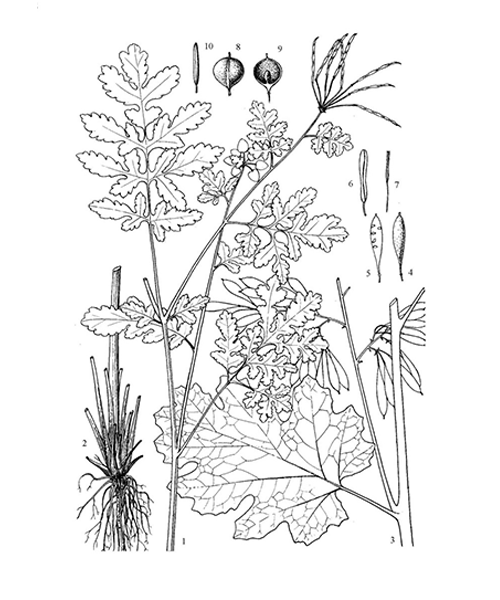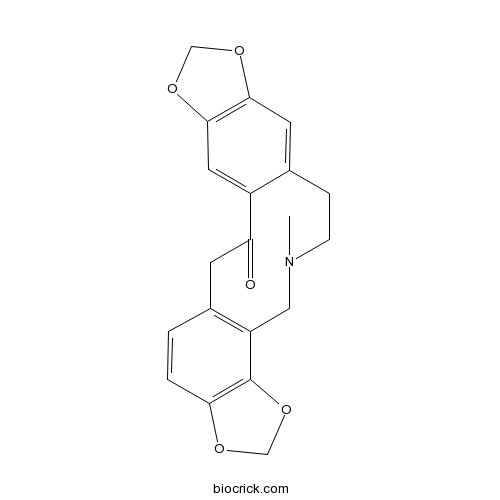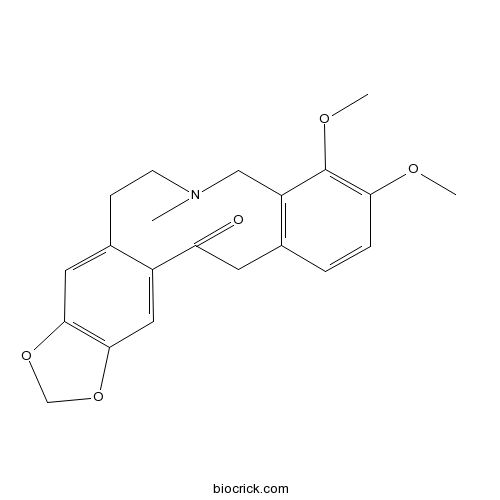Macleaya cordata
Macleaya cordata
1. The products in our compound library are selected from thousands of unique natural products; 2. It has the characteristics of diverse structure, diverse sources and wide coverage of activities; 3. Provide information on the activity of products from major journals, patents and research reports around the world, providing theoretical direction and research basis for further research and screening; 4. Free combination according to the type, source, target and disease of natural product; 5. The compound powder is placed in a covered tube and then discharged into a 10 x 10 cryostat; 6. Transport in ice pack or dry ice pack. Please store it at -20 °C as soon as possible after receiving the product, and use it as soon as possible after opening.

Natural products/compounds from Macleaya cordata
- Cat.No. Product Name CAS Number COA
-
BCN6165
Protopine130-86-9
Instructions

-
BCN8346
6- Methoxydihydrosanguinarine151890-26-5
Instructions

-
BCN8322
Chelerythrine chloride3895-92-9
Instructions

-
BCN9043
Allocryptopine485-91-6
Instructions

-
BCC6481
Sanguinarine chloride5578-73-4
Instructions

-
BCN2273
Dihydrochelerythrine6880-91-7
Instructions

Hairy root induction and benzylisoquinoline alkaloid production in Macleaya cordata.[Pubmed: 30097605]
Sanguinarine is currently widely used to replace antibiotic growth promoters in animal feeding and has demonstrated useful anticancer activity. Currently, the main source of sanguinarine is from an important medicinal plant, Macleaya cordata. To obtain a new source of sanguinarine production, we established hairy root cultures of M. cordata by co-cultivating leaf and stem explants with Agrobacterium rhizogenes. Except the co-cultivation medium, all growth media contained 200 mg/L timentin to eliminate A. rhizogenes. Through comparing the metabolic profiles and gene expression of hairy roots and wild-type roots sampled at five time points, we found that the sanguinarine and dihydrosanguinarine contents of hairy roots were far higher than those of wild-type roots, and we revealed the molecular mechanism that causes these metabolites to increase. Consequently, this study demonstrated that the hairy root system has further potential for bioengineering and sustainable production of sanguinarine on a commercial scale. To the best of our knowledge, this is the first efficient protocol reported for the establishment of hairy root cultures in M. cordata using A. rhizogenes.
[Non-alkaloid Chemical Constituents from Macleaya cordata].[Pubmed: 30088886]
To study the non-alkaloid chemical constituents of Macleaya cordata.
[Study on Alkaloids of Fruit from Macleaya cordata].[Pubmed: 30080360]
To study the alkaloids from the fruit of Macleaya cordata.
Several newly discovered Mo-enriched plants with a focus on Macleaya cordata.[Pubmed: 29987470]
Phytoremediation as an alternative strategy has been a widespread attention. The screening of enriched plants and hyperaccumulators is the key of the strategy. So this study examined the status of heavy metal pollution in molybdenum (Mo) mine soils, metal accumulation in plants growing on mine, and their tolerance strategies. The analysis of 14 soils and 27 plant samples in mining area showed that Mo, zinc (Zn), and cadmium (Cd) concentrations exceeded soil safety standards and their levels varied in 27 plant samples. Mo was the heavy pollution with an average total content of 256.1 mg/kg in soils. As Mo-enriched plants, Mo concentrations of Macleaya cordata (Willd.) R. Br. and Morus australis Poir. were 704.4 and 772.4 mg/kg, respectively. M. cordata was selected as the research material, due to its high biomass. Molybdenum significantly decreased the biomass and photosynthesis of M. cordata at high concentration (> 200 μmol/L), but its biomass and photosynthesis reached the maximum after 50 μmol/L Mo treatment, respectively. Analysis of the subcellular distribution and chemical speciation showed that Mo was distributed a certain way in the extracts and that this suggested that it may be present in cell wall and soluble fraction of roots (51.9-63.9%; 26.1-44.7%) or shoots (30.0-44.4%; 47.3-56.0%) and complexed to organic acid, pectate, oxalate, and protein. This might be responsible for the adaptation of M. cordata to Mo stress. Therefore, M. cordata could serve as a potential plant to utilize for the phytoremediation of Mo-contaminated soil.
Preparation and application of magnetic molecularly imprinted polymers for the isolation of chelerythrine from Macleaya cordata.[Pubmed: 29917314]
None
The impacts of Macleaya cordata extract and naringin inclusion in post-weaning piglet diets on performance, nutrient digestibility and intestinal histomorphology.[Pubmed: 29668316]
The current study investigated the impacts of supplementation of post-weaning piglet diets with Macleaya cordata extract (MCE) and naringin (NAR) on performance, nutrient digestibility and intestinal histomorphology. Post-weaning crossbred piglets (28 males and 28 females; age at weaning 25 d) were randomly allotted to 28 pens. The experiment consisted of a control and three treatment groups (MCE60, MCE120 and NAR). For diets MCE60 and MCE120, the control diet was supplemented with 60 and 120 mg Sangrovit® Extra (a standardised premixture of MCE) per kg diet, respectively. Group NAR received 50 mg pure NAR per kg diet. The experiment lasted 42 d (d 25 - 66 of age). At d 66, apparent pre-caecal digestibility (APD) of nutrients was determined and histomorphological changes in mid-jejunum were evaluated. Feeding diets MCE120 and NAR improved body weight gain and feed conversion ratio of piglets. After feeding diets MCE120 and NAR, the APD of phosphorus and different single and total amino acids were greater than after feeding the control diet. The present data demonstrated that supplementation of post-weaning piglet diets with 120 mg MCE or 50 mg NAR per kg diet could improve growth performance and nutrient digestibility and had no impact on histomorphological variables in the jejunum. These findings indicate the potential of these products to be used as growth promoters in pig nutrition.
Isoquinoline alkaloids supplementation on performance and carcass traits of feedlot bulls.[Pubmed: 29514431]
Isoquinoline Alkaloids, derived from one plant (Macleaya cordata) can be an alternative when it is desired to increase performance in feedlot cattle. However, results on these nutritional additives in high energy diets in ruminants are still incipient in literature. In this context, the objective of this study was to evaluate performance and carcass traits of feedlot bulls supplemented with sanguinarine, the main alkaloid presents in Macleaya cordata in high energy density diets.
Molluscicidal activity and physiological toxicity of Macleaya cordata alkaloids components on snail Oncomelania hupensis.[Pubmed: 29183578]
None
LC-MS guided isolation of three pairs of enantiomeric alkaloids from Macleaya cordata and their enantioseparations, antiproliferative activity, apoptosis-inducing property.[Pubmed: 29133815]
None
Medicinal plants of the genus Macleaya (Macleaya cordata, Macleaya microcarpa): A review of their phytochemistry, pharmacology, and toxicology.[Pubmed: 29130543]
In the genus Macleaya, Macleaya cordata and Macleaya microcarpa have been recognized as traditional herbs that are primarily distributed in China, North America, and Europe and have a long history of medicinal usage. These herbs have been long valued and studied for detumescence, detoxification, and insecticidal effect. This review aims to provide comprehensive information on botanical, phytochemical, pharmacological, and toxicological studies on plants in the genus Macleaya. Plants from the genus of Macleaya provide a source of bioactive compounds, primarily alkaloids, with remarkable diversity and complex architectures, thereby having attracted attention from researchers. To date, 291 constituents have been identified and/or isolated from this group. These purified compounds and/or crude extract possess antitumor, anti-inflammatory, insecticidal, and antibacterial activities in addition to certain potential toxicities. Macleaya species hold potential for medicinal applications. However, despite the pharmacological studies on these plants, the mechanisms underlying the biological activities of active ingredients derived from Macleaya have not been thoroughly elucidated to date. Additionally, there is a need for research focusing on in vivo medical effects of Macleaya compounds and, eventually, for clinical trials.


